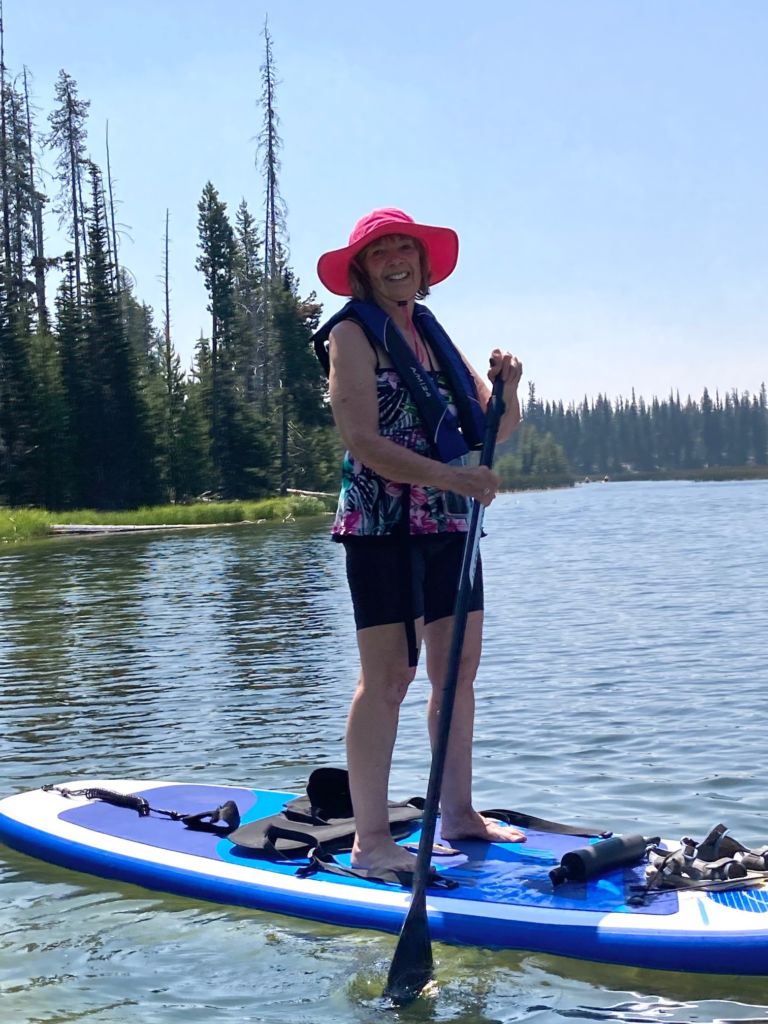Whether you are new to paddle sports like stand-up paddle boarding and kayaking or canoeing or you have been gliding across the open water for years, it’s important to be mindful of the potential for injury. Without proper training to increase strength and stability, paddle sports can quickly wind up a (literal) pain!
Common injuries include those to the shoulders, wrists and lower back. While some Delayed Onset Muscle Soreness (DOMS) is to be expected after a day on the water, nagging or debilitating pain may indicate something more is going on and you should reach out to your local physical therapist for an evaluation. At Therapeutic Associates Physical Therapy, our experts want to help you continue all of the adventurous activities you enjoy and can get you back on your SUP or into your kayak or canoe before the long, warm days are behind us.
Power up your paddling!
A simple workout plan that includes exercises for cardiovascular endurance as well as strength training and core stability – all important if you want to remain upright and afloat – is the best way to ensure you keep your body healthy and happy throughout the paddling season.
So, whether you plan to increase your speed and performance on your SUP or in your kayak, or just simply want to enjoy leisurely paddles on the wonderful lakes and rivers nearby, start incorporating these exercises into your routine today!
To gain the most benefit for your paddling outings, it is ideal to start your exercise training 6-8 weeks prior to your first venture out. This allows proper muscle hypertrophy (growth of the muscle belly), muscle strength (increased power and ability of the muscle), and muscular endurance (the amount of time a muscle can withstand the demands and work continuously without tiring). For many of us, however, the seasons change quickly and before we know it, we are in the midst of summer and don’t have that kind of time. Don’t worry, you don’t have to wait weeks before you make your plans. These are all exercises that you can begin to incorporate into your normal routine in conjunction with your paddling sports.
The recommended dose and frequency, if you are just getting started with these paddling exercises, is strength training 3-4 x a week, with 1 day of rest in between. This cadence allows your muscles to recover between workouts. Additionally, you can break up your workouts into specific muscle groups.
For example:
- Monday: shoulders/chest strengthening
- Wednesday: leg strengthening
- Friday: back strengthening
- Weekend: core and balance-specific exercises
4 Key Exercises for the Shoulders
RTC (Rotator Cuff) strengthening emphasis with the use of a resistance band, such as Theraband.
- Bilateral (Both arms) external rotation
- Horizontal abduction
- Single arm bent over row
- 90-degree lat pull down with an optional side chop
3 Key Exercises for Standing Balance
Double and single limb balance on various surfaces (examples: grass, pillow, Bosu ball) utilizing progressions to increase difficulty
Single leg deadlift – option: hold a dumbbell or kettlebell to add weight and increase the challenge
Hip clock circles – mini circles with the leg forward, to the side, and to the back
3 Key Exercises for Core Strength
Wood chops with medicine ball/weight or cable/resistance band – try it in a split stance lunge position for more of a challenge
Palloff Press – focus on no body movement while pressing straight forward; try a side step while holding arms straight forward, away from the torso
Side-lying plank with oblique twist – modification: bend the knees and drop to the ground while keeping hips lifted
In addition to these exercises, find something you enjoy doing that gets your heart pumping to improve your cardiovascular endurance. Commit to a burpee challenge, create a routine with fun, youthful activities such as jump rope, hula hoop, and bear crawls, swim some laps, or try out the rowing machine or any other cardio equipment at your gym. The best exercise is the exercise you’ll stick to!
What should I do before paddling?
It is critical that you prime your muscles and joints prior to hopping in your kayak or on your stand up paddle board to prevent injury from occurring. The best option is to start with a dynamic warm-up, which consists of a moving warm-up to increase blood flow and lubrication of the joints and other soft tissues through a sports-specific range of motion. Dynamic stretching/warm-up allows the body to rehearse and mimic similar movement patterns that will be completed while you are on the water to allow for proper coordination and improve overall performance.
Dynamic warm-up options with the use of your paddle:
Standing overhead side bend with paddle:
- Begin in a standing upright position holding a paddle overhead with shoulders reaching upright.
- Slowly side bend to the right and then alternate to the left.
- Make sure to keep your core engage to keep the back protected.
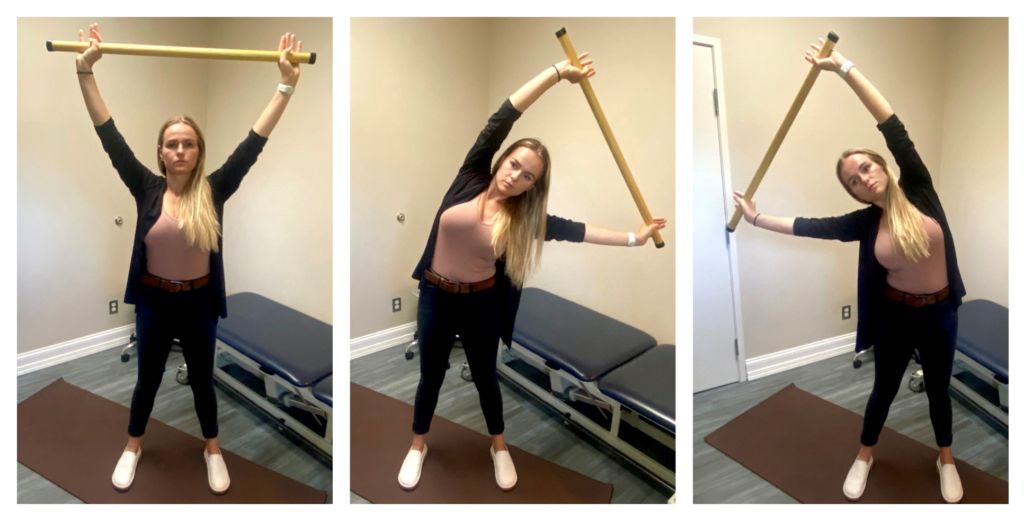
Standing trunk twists with paddle:
- Begin in a standing upright position holding a paddle across your shoulders.
- Slowly rotate your trunk to one side, then return to the starting position and repeat to the other side.
- Make sure to maintain an upright position as you rotate your trunk, and do not let your chin jut forward.
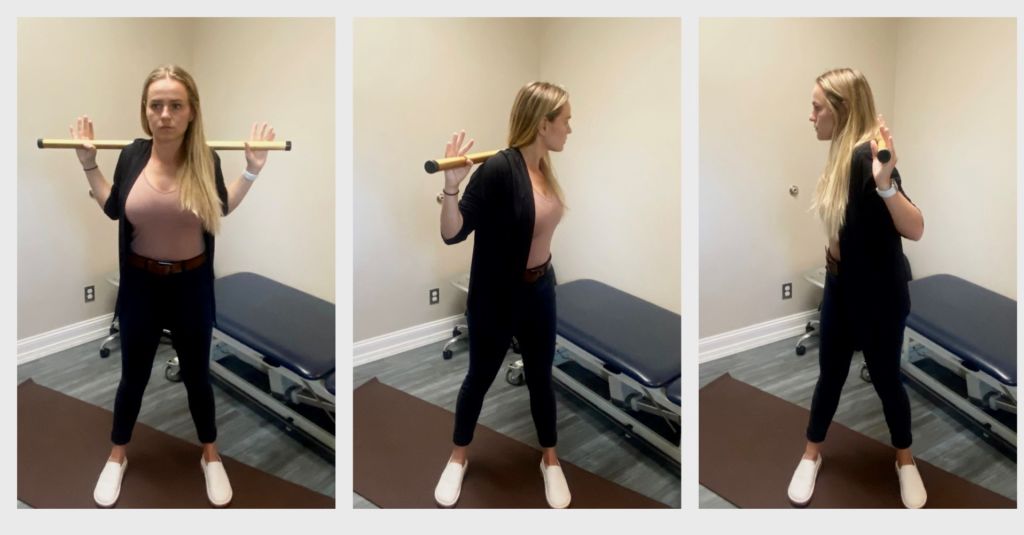
Bent over trunk twists with paddle:
- Begin in a standing upright position holding a paddle across your shoulders.
- Bend forward at your hips, then slowly rotate your upper body to one side, and then the other.
- Make sure to keep your back straight during the exercise. Your trunk and shoulders should move as one unit.
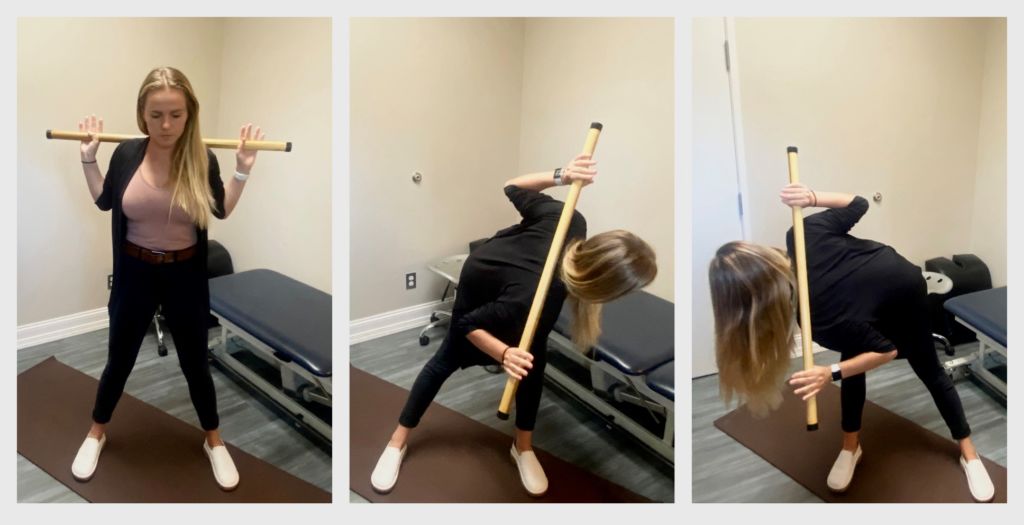
What should I do after paddling?
After paddling for the day, it is important to cool down. Static stretches ensure that your muscles remain elongated and help you avoid stiffness throughout the soft tissues and joints. Static stretches should be held for a minimum of 30 seconds to gain maximum stretching benefits.
Cool down/static stretching post stand-up paddle boarding/kayaking:
Hip flexor stretch in high kneeling position:
- Begin in a half kneeling position with one knee bent in front of your body.
- Tighten your abdominals, tuck your pelvis under, and gently push your hips forward. You should feel a stretch in the front of your hip.
- Make sure to keep your hips facing forward and back straight during the exercise.
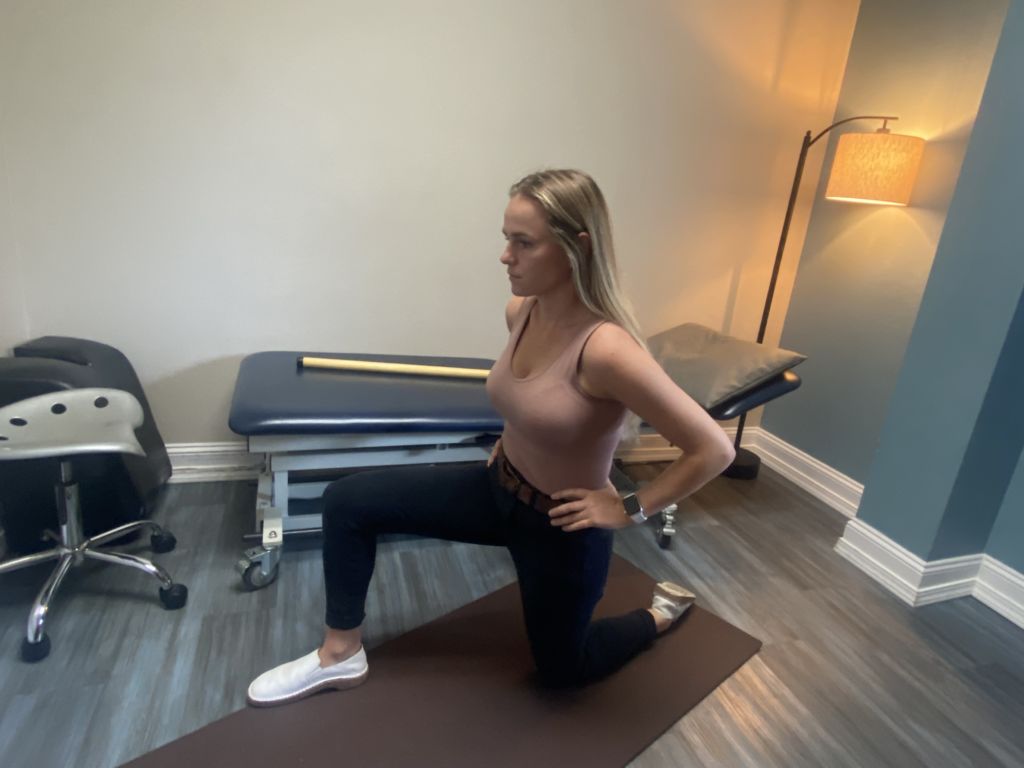
Hamstring stretch
- Begin sitting upright with one leg straight forward and your heel resting on the ground.
- Bend your trunk forward, hinging at your hips until you feel a stretch in the back of your leg. Hold this position.
- Make sure to keep your knee straight during the stretch and do not let your back arch or slump.
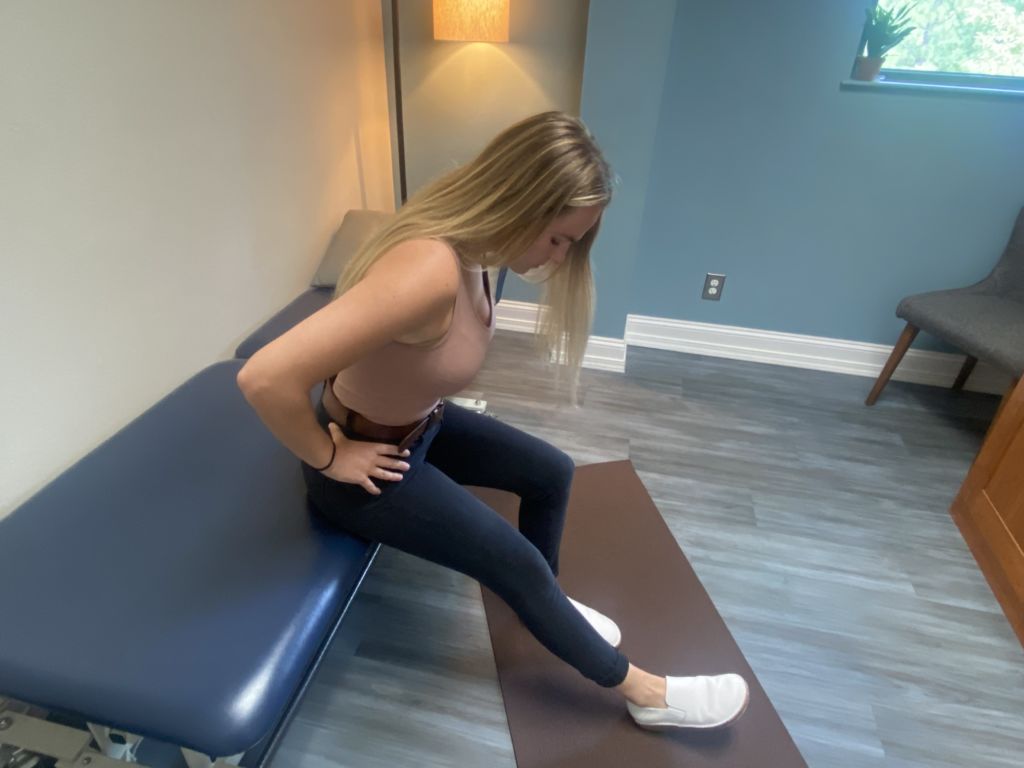
IR (Internal Rotator) stretch using paddle:
- Begin in a standing position, holding the ends of a dowel in each hand, with one arm behind your head and the other behind your low back.
- Slowly pulling up on the cane, bending your lower arm, until your feel a stretch in your shoulder. Hold this position.
- Make sure to keep your back straight during the exercise.
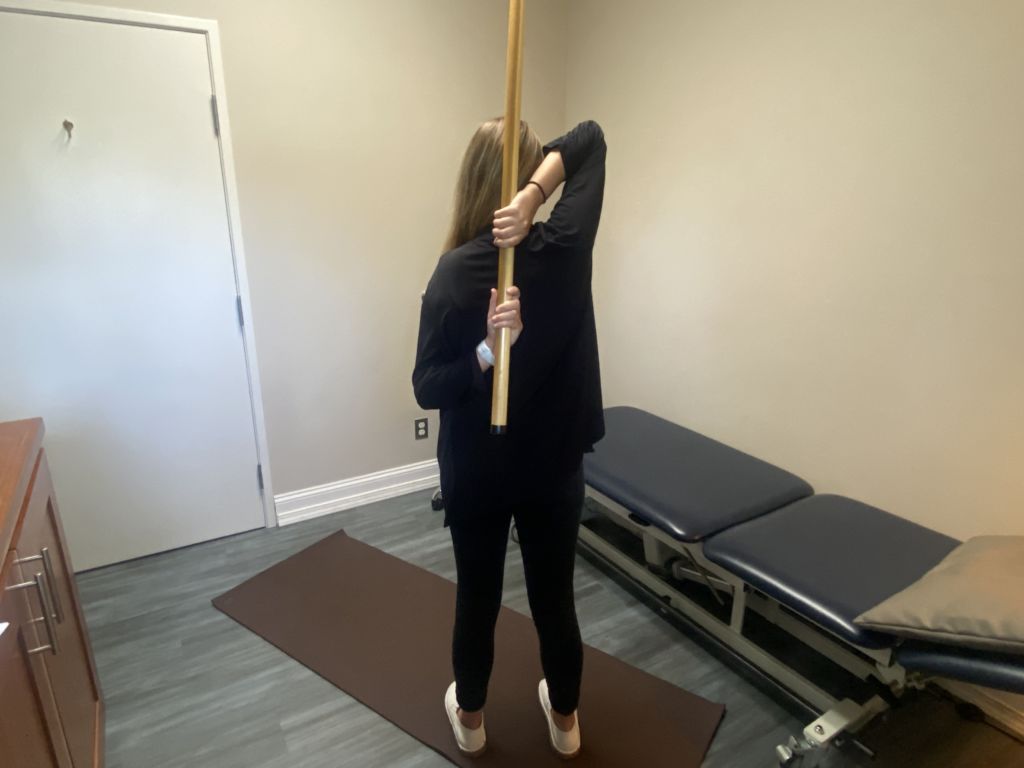
Following these tips and incorporating these paddleboarding exercises and kayaking exercises into your workout routine will help ensure you get the most out of the paddling season. Unfortunately, injuries do happen, even when we do all the right things to avoid them. If you do find yourself hurt and unable to go out on your SUP or in your kayak or canoe, physical therapy can help! Our musculoskeletal experts will work with you to assess your injury and get to the root of the problem. By creating an individualized plan of care, we will not only address your pain point, but we will teach you how to avoid reinjury in the future. If you’re planning to go paddling for the first time ever, consider a PT consult first to be sure your body is ready, and to learn about proper training to avoid injury and improve enjoyment.
We look forward to being a part of your healthcare team.
Paddleboarding and kayaking are fun, active sports that are also unique forms of exercise and offer a great way to develop your overall fitness. Physical therapy is one of the most effective ways to reduce the risk of injury, improve function, and decrease pain. Our experts are here for you and will use their evaluation and clinical reasoning skills to develop an individualized treatment plan designed to ensure you get the most out of your paddling season.
